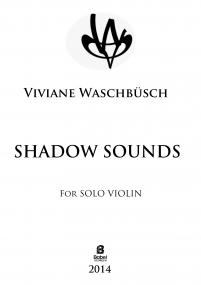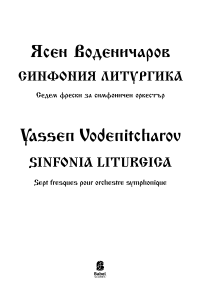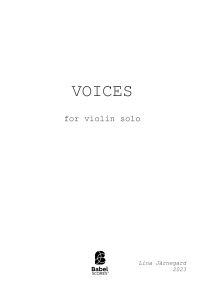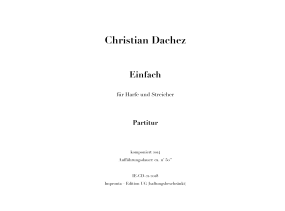In a weightless quiet
ISMN : 979-0-2325-5462-4
- Login to create your own lists
Program notes
In a weightless quiet, for solo violin (2020)
In a weightless quiet belongs to a group of works that I started to write in 2019, in which I explore the formal and structural potentials of an acoustic phenomenon known to all musicians when they tune their instruments: the beats that occur when two tones of very close frequencies are played at the same time. The first work in this group is for viola and ensemble (Geister, schwebende Geister, for viola and ensemble 2019-20); the second is this violin piece and the third to date is my second string quartet Canto de amigo written in 2020. In each of these works, the beats are generated by playing one of the open strings of the instruments at the same time as a similar pitch with a microtonal deviation, on another string.
What I find fascinating in this use of controlled beat patterns is that they actually permit to directly experience what is usually considered a physical/mathematical concept. In sensory experience (auditory perception), we cannot be aware of the mathematical ratio between the frequencies of two notes played at the same time; it's an abstract concept (we don't hear a 3:2 ratio when we hear a fifth; we hear a fifth). But when the pitches are very close, the phenomenon of "first-order beat" becomes an actual experience. How this works is fairly simple to explain: if for example, the two frequencies are 3 Hz apart—say, 443 Hz and 440 Hz—we hear two things: first, the two original frequencies become one single tone (mathematically, it’s the median value of the two); additionally, we hear a pulsation of three beats animating this single tone. The “median value” in this case is 441.5 Hz; and the pulsation that accompanies it—the difference between the two original frequencies—is three beats per second which, when we hear them, is the audible manifestation of an arithmetic equation, in this case, the subtraction 443 - 440 = 3!
The form of In a weightless quiet is based on a series of sections that explore the tonal regions of the three open strings of the violin A, D and E, and their extensions through microtones that generate 3, 5, 7 and 11 beats per second. After an introduction centered on A, the sections that follow tend to begin with the low D and ascend from to A and E in several successive waves. The focus on these three tonal regions and their interactions with each other give each section a particular color and character. The phenomenon of beats itself can be presented in gestures that are sometimes too fast for the pulsations to be clearly audible (as in the very beginning for example). At other times, longer held notes make them clearer and the beatings are then clearly perceived as regular rhythmic subdivisions of the basic pulse. So, when they are not clearly heard, one cannot be sure whether it's because the pitches are “out of tune” or whether they express something else. When the line slows down, the beats are revealed without ambiguity. In between these two extremes, there is a whole vocabulary of gestures that can evoke these subdivisions in different ways: repeated notes, slow or rapid alternance between two strings, tremolos etc. I find fascinating how these beats have a sort of other-worldly character, appearing seemingly out of nowhere since they are not directly produced by the performer, who is playing two pitches but not the rhythmic beating itself.
Pages - 22











